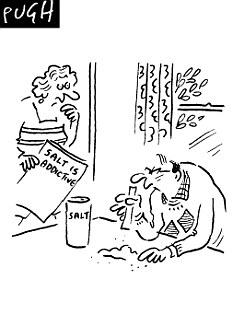How to eat less salt
|
There are a number of simple ways that you can reduce your salt intake. By understanding the truth behind some common salt myths, learning how to read labels and understanding which foods are high in salt, you can watch what you’re eating at home and when you’re eating out. Give yourself time to adjustMany of us have developed a preference for salty flavours due to years of eating manufactured foods with a high salt content as well as the use of salt as seasoning. Initially when you reduce your salt intake foods tend to taste bland, but after two or three weeks you will start to taste the real and delicious flavour of natural food. Give yourself time to adjust. In the tips for eating at home, you’ll find alternative ways of adding flavour to your food. |
 |
Foods that contain salt
It can be surprising which foods add the most salt to our diets. Everyday foods which push up our salt intakes include bread, salads, sandwiches, soups, processed and smoked meat and fish, cheese, cooking sauces and table sauces.
Click here [PDF 606KB] to download the table below to see which foods are high, low and medium in salt, so you can make simple swaps. Our tips for eating at home and eating out, and our low salt recipes, will show you where you can make positive changes.

We carry out food product surveys which show just how much, or how little, salt can be contained in popular products such as sausages, salads, bread and soups. Click here to see our salt surveys.
The National Diet & Nutrition Survey, published annually, shows the percentage contribution of various foods to the total amount of salt (and other nutrients) in our diet. Some foods that we eat every day are not particularly high in salt, but because we eat them often, are responsible for a large part of our daily salt intake. The latest survey shows that bread adds more salt to our diet than any other food, responsible for a fifth of our salt intake 18%! For more information click here
Foods that are often high in salt
| Anchovies Bacon Cheese Chips (if salt added) Coated chicken e.g. nuggets Corn snacks e.g. Wotsits Gravy granules |
Ham Noodle snacks pots Olives Pickles Potato snacks e.g. Hula Hoops Prawns Salami |
Salted and dry roasted nuts Salt fish Sausages Smoked meat and fish Soy sauce Stock cubes and bouillon Yeast extract e.g. Marmite |
Foods where some brands are high in salt
| Baked beans Biscuits Burgers Breakfast cereals Bread and bread products Cakes and pastries |
Cooking sauces Crisps Filled pasta Pasta sauces Pizza Potato croquettes |
Ready meals Soup Sandwiches Sausages Tinned pasta Tomato Ketchup |
Foods that are low in salt
| Breakfast cereals* e.g. Shredded Wheat Couscous Eggs Emmental Fresh fish Fresh meat and poultry Fromage frais |
Fruit and Vegetables (dried, fresh, frozen and tinned)** Homemade bread* Homemade sauces* Homemade soup* Mozzarella Pasta and Rice Plain cheese spreads |
Plain cottage cheese Plain popcorn Porridge oats Pulses (peas, beans, lentils)** Ricotta Seeds Unsalted nuts Yogurt |
* with no added salt
** choose tinned products with no added salt
How you can help us all eat less salt
Whether you are a chef, a restaurant owner, a food manufacturer or a customer wanting to eat less salt, we would welcome your support of our campaign. By getting involved in this campaign you would be helping Action on Salt to bring about a reduction in the salt contained in food which will help to reduce the number of people suffering from heart attacks, strokes and numerous other diseases.


